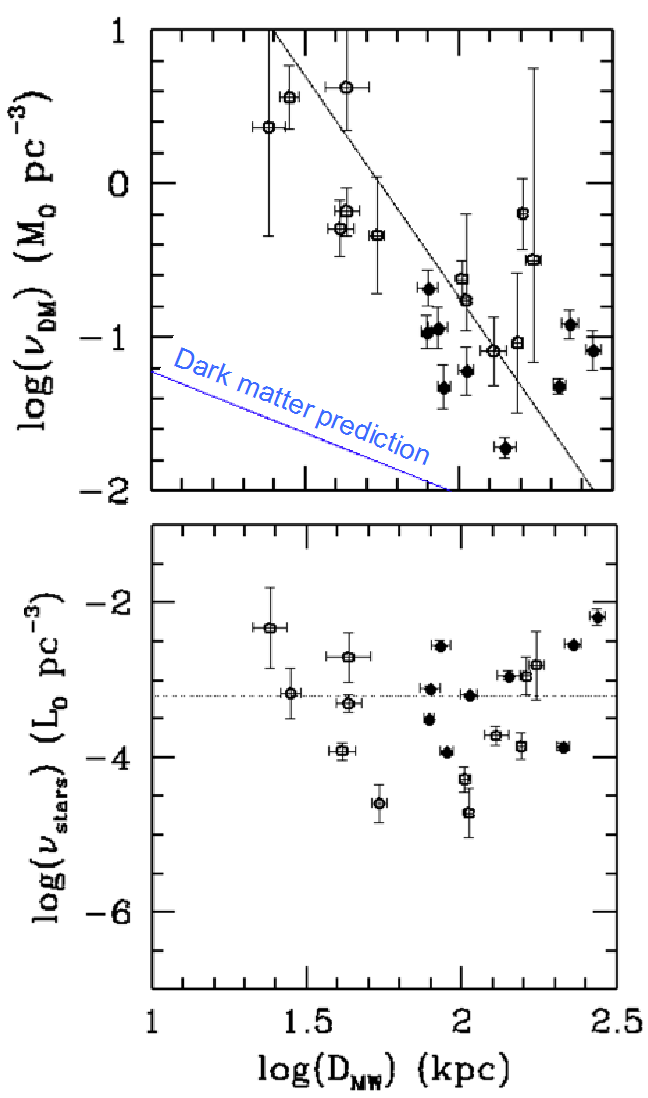For virtually the last fifty years, the presence of dark matter on all cosmic scales has been at the heart of modern cosmology.
It is at the smallest scales of the Universe, within the dwarf galaxies surrounding the Milky Way, the smallest which we can observe, that the dark matter is thought to be the most abundant. It is in these galaxies that one observes exceptionally large stellar motions, interpreted by cosmologists as an effect of enormous quantities of dark matter, having a mass of up to many thousands of times greater than that of the stars. Since the 1980s, this dark matter has been considered to be essential in order to understand how galaxies remain intact : it increases a gravitational effect which compensates the stellar motions which tend to disperse the structure.
One believed moreover that the dwarf galaxies had been satellites of our Milky Way for many billions of years, thus explaining how equilibrium had been maintained over very many billions of years. But is that really so ?
A Franco Chinese team at the Paris Observatory-PSL within the Dept. of Galaxies, Stars, Physics and Instrumentation - GEPI (Observatoire de Paris - PSL / CNRS) and of the National Astronomical Observatory of China (NAOC) has upset this scenario by proposing a fresh interpretation without recourse to dark matter. To do this, the scientists have used the most accurate astrometric, spectroscopic, and photometric data available to date.
Since the publication of the second Gaia catalogue in 2018, the orbits of dwarf galaxies are known much more accurately. The team discovered that being very eccentric, they did not verify the scenario according to which the dwarf galaxies would have been satellites of the Milky Way for billions of years. In fact, the galaxies would have been captured by the Milky Way, and that quite recently.
Recently obtained data from the Canada-French-Hawaiian Telescope (CFHT) and from the Magellan telescope, via the deepest observations in imagery and in spectroscopy of dwarf galaxies, have moreover yielded the most accurate determinations of their speeds, radii, distances and stellar content masses.
Using all this new data, the scientific team discovered how these galaxies arrived in the vicinity of our galaxy and how their dynamics is determined just by the gravitational tidal effects of the Milky Way only, just via Newtonian physics.
A new scenario
The resulting very robust scenario consists of many steps (see the video).
The initial state consists of very small dwarfs, so-called irregular, galaxies dominated by cold gas.
- 1. Attracted by the Galaxy, they enter its halo. Via the effects of ram or dynamical pressure, their own gas is torn away by that of the halo. The loss of gas leads to a loss of gravity : their stars are heavily « perturbed » and go away in all directions.
- 2. The gravitational effects of the Milky Way now play a part, via tidal shocks, - somewhat as what created the globular clusters. In short, within the dwarf galaxies, shocks shake up the stars, which are then captured via a resonance effect along a particular direction, which links them to the centre of the Milky Way.
- 3. Since the line of sight of astronomers – situated of course within our Galaxy – is essentially in this direction, the observations obtained are compatible with the predicted increase in the stellar motions due just to tidal shocks, without recourse to dark matter.
Can this scenario alone exclude the presence of dark matter in dwarf galaxies ?
Many observations suggest that this hypothetical dark matter would have no effect on the physical properties of dwarf galaxies.
To begin with, astronomers have been able to calculate the accelerations produced by tidal shocks. They have found that, within measurement error, they coincide with those supposed to have been produced by dark matter (see Figure 1). The agreement is rather surprising. Is it possible that tidal shocks have been interpreted as the presence of dark matter ?
At present, models based on dark matter apparently cannot reproduce the numerous scale relations encountered between the fundamental parameters of dwarf galaxies : radii, distances, speeds, stellar masses. However, these scale relations are completely explained by the tidal shock scenario.
Potentially, these results could have far reaching consequences for our understanding of the Universe, upsetting decades of work in cosmology. In particular, the most current cosmological models imply that there are many dark matter halos around dwarf galaxies in the neighborhood of large galaxies like the Milky Way. If there is no dark matter which can act on the dynamics of these dwarf galaxies, either the dwarf galaxies surrounding the Milky Way are in some way exceptional, or the cosmological models will have to be reviewed.
Video
See with a video, via Youtube of the Paris Observatory, the physical transformation of dwarf galaxies in the halo of the Milky Way :

Images


Reference
This research has been published as a paper entitled “On the absence of dark matter in Milky Way dwarf galaxies”, by F. Hammer et al., to be published in the October 2019 issue of the journal Astrophysical Journal (arXiv:1812.10714).
https://iopscience.iop.org/article/10.3847/1538-4357/ab36b6
Collaboration
The scientific team is composed of François Hammer (Observatoire de Paris – PSL - CNRS), Yanbin Yang (Observatoire de Paris – PSL - CNRS), Frédéric Arenou (Observatoire de Paris – PSL - CNRS), Carine Babusiaux (Université Grenoble Alpes), Jianling Wang (National Astronomical Observatory of China), Mathieu Puech (Observatoire de Paris – PSL - CNRS) and Hector Flores (Observatoire de Paris – PSL - CNRS).

